As a fundamental building block of music theory, major 2nd intervals play a significant role in shaping melodies, harmonies, and musical progressions. Whether you’re a budding musician, a music student, or simply curious about the inner workings of music, understanding major 2nd intervals is essential for expanding your musical vocabulary.
In this article, we’ll explore the characteristics or the Major 2nd interval, give you examples to listen to and help you recognise it by ear.

Major 2nd Interval Songs
Here are some famous examples of major 2nd intervals in popular songs. There really are too many to choose from as any two notes that are a whole-step (tone) apart are classified as a Major 2nd interval.
Happy Birthday
As you can see from the diagram, the C from ‘happy’ to the D note on ‘birth’ is a major 2nd.

Taylor Swift ‘ Today was a Fairytale’
Just before the chorus, the line ‘Time Slows Down’ contains a Major 2nd that’s easy to spot. The E to F# on the ‘Time Slows’ part of the line.

Mary had a Little Lamb
The E to D and C to D are both examples of a Major 2nd. Remember that we always name an interval based on the lower note. For E to D, we can see that the notes are two half-steps apart. Also E is the second note of the D major scale.

What is a Major 2nd Interval?
Firstly, the definition of an interval is the distance between two notes. We could play the notes at the same time, a harmonic interval, or one of the other, a melodic interval. So how can we describe the distance between two notes.

Using whole steps and half-steps (tones and semitones)
We could describe an interval in terms of the number of half-steps for the lower note to the upper note. For a major 2nd we have to go up two half-steps or one whole-step to create the interval.

Using scales to name intervals
Simply put scales are patterns of half-steps and whole-steps. In the major scale, the 2nd degree will be one whole-tone above the root note. This interval is therefore call a Major 2nd.

Ear Training and Intervals
To develop as a musician you’ll want to be able to recognise intervals by ear. This is where ear training comes in, as the more you practice, the better your’ll get.
My recommendation for this is Tonegym as they have a comprehensive and fun program for training your ears. It’s what has gotten the best results with for my own students.
In the ‘tools’ section of their site, Tonegym even have an interval memorizer that allows you to learn every type of interval.
For an in-depth look at ear training, here’s my full review of Tonegym.
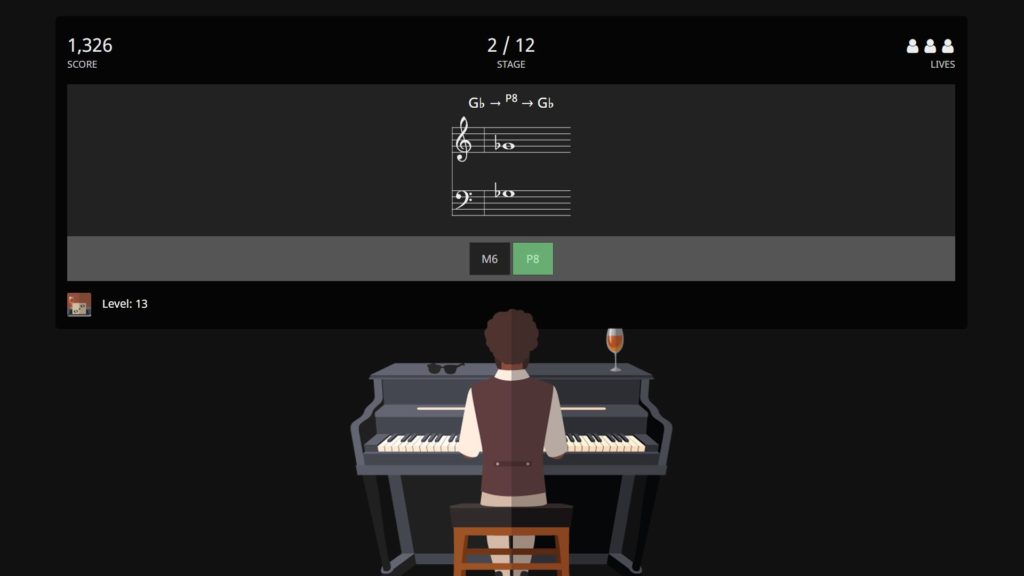
Examples of Major 2nd Intervals
Here is a table which shows Major 2nds across a whole octave. Remember that to name an interval as yourself ‘Which degree of the lower note’s scale is the higher note?’
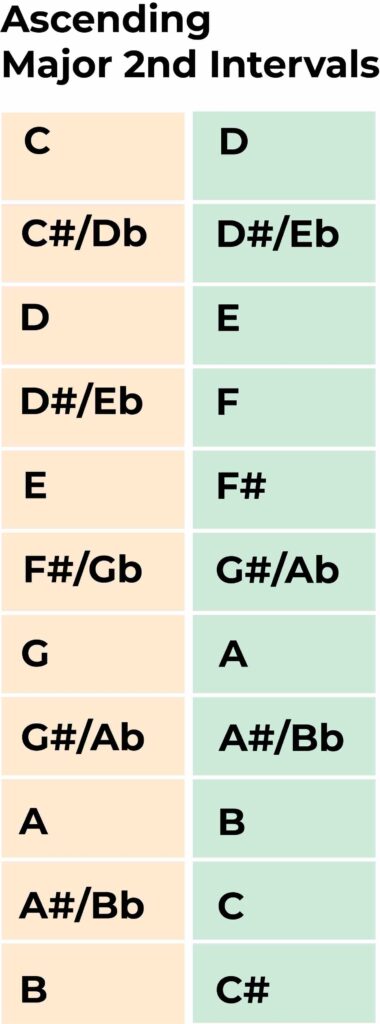
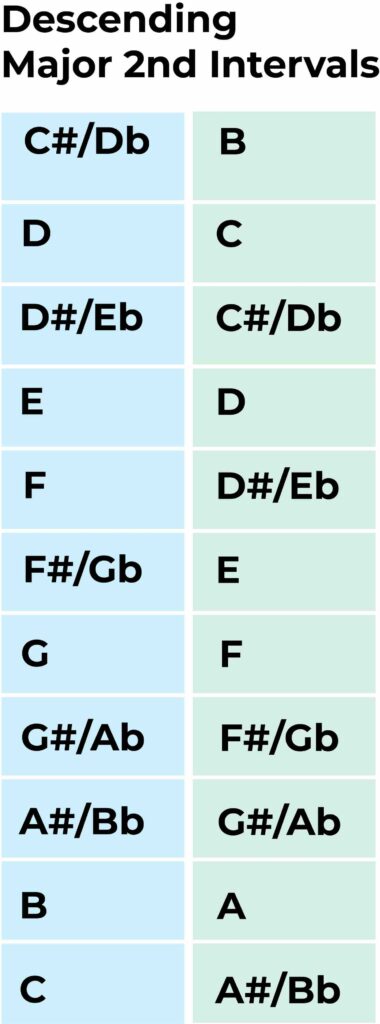
Major 2nd Interval Qualities
We can describe the sound of intervals using a numbers of adjectives. An interval can sound ‘stable’ or ‘grounded’ like a perfect 5th, or it could sound ‘dissident’, ‘neutral’ or even ‘sinister’.
The sound of a major 2nd can vary depending on the context and the tuning system. historically, it was considered one of the most dissonant intervals ion the diatonic scale, but in modern music is also sound consonant or natural. It can evoke feelings of happiness, lightness and neutral feelings, especially when used in melodies like’ Happy Birthday’ or ‘When the Saints Go Marching In’. It can also sound unstable or tense when used in chords like sus2 or add2, which often resolve to more stable chords. More on suspended chords here.
How to Identify Major 2nd Intervals by Ear
The best way to start identifying Major 2nd intervals is by listening to reference songs like the ones above. This will give you a reference point to look back at when listening to new pieces.
The solfege system can also help as ‘do-re’ is a major 2nd interval (C to D).
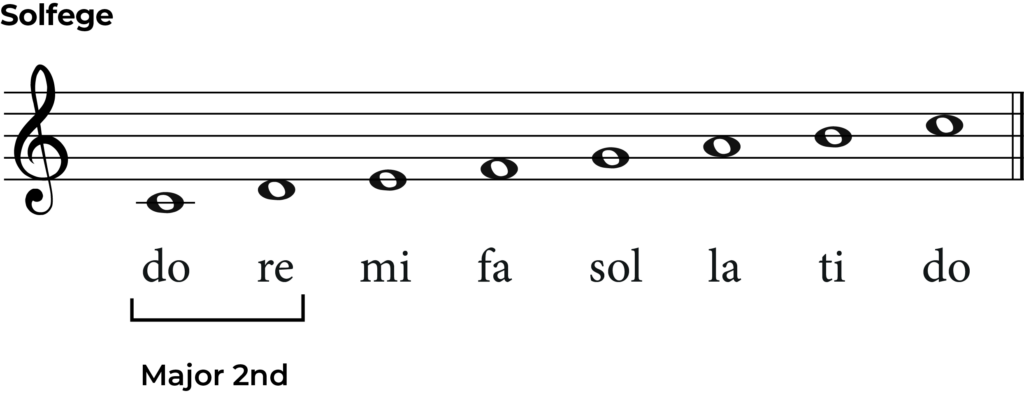
ToneGym- The Ultimate Ear Training App
ToneGym allows you to improve your ear with a range of games, interactive and competitions.
Or check out our complete review of ToneGym.

How to Sing and Play Major 2nd Intervals on Your Instrument
If you are a pianist then playing a major 2nd couldn’t be easier. Moving up two keys (or half-steps) will give you a Major 2nd. Check out the examples below.
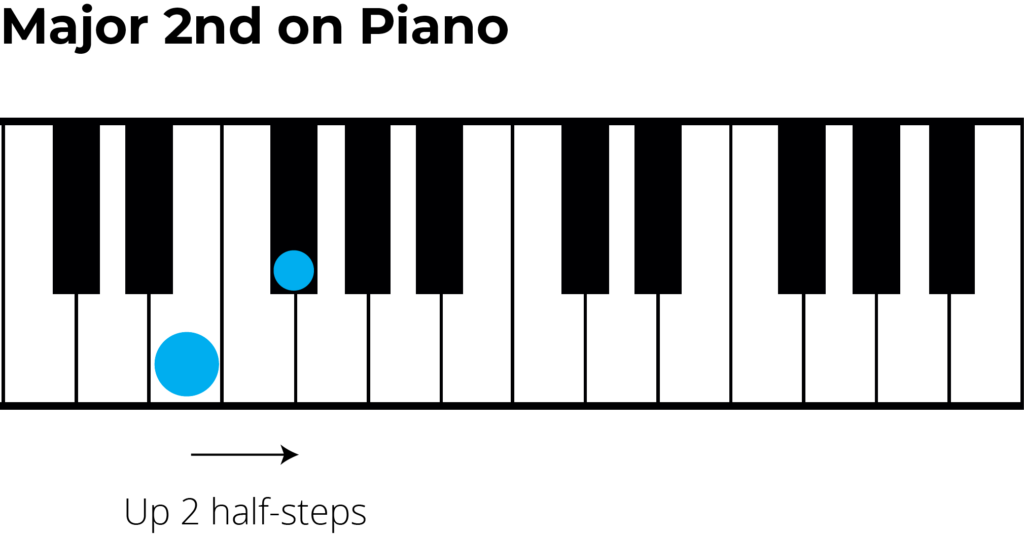
Major 2nd intervals on guitar are also simply to play. Fret any note and then play the note two frets up. This will be a Major 2nd interval. See the examples below.

Major 2nd Intervals and the Whole Tone Scale
The whole tone scale is essentially a series of Major 2nd intervals. This is because a whole tone, or whole step is the definition of a major 2nd interval.

For more check out our Whole Tone Scales Complete Guide.
What’s next….?
- Learn about the Minor 2nd interval
- Expand your interval knowledge with out complete guide to intervals.
